Share
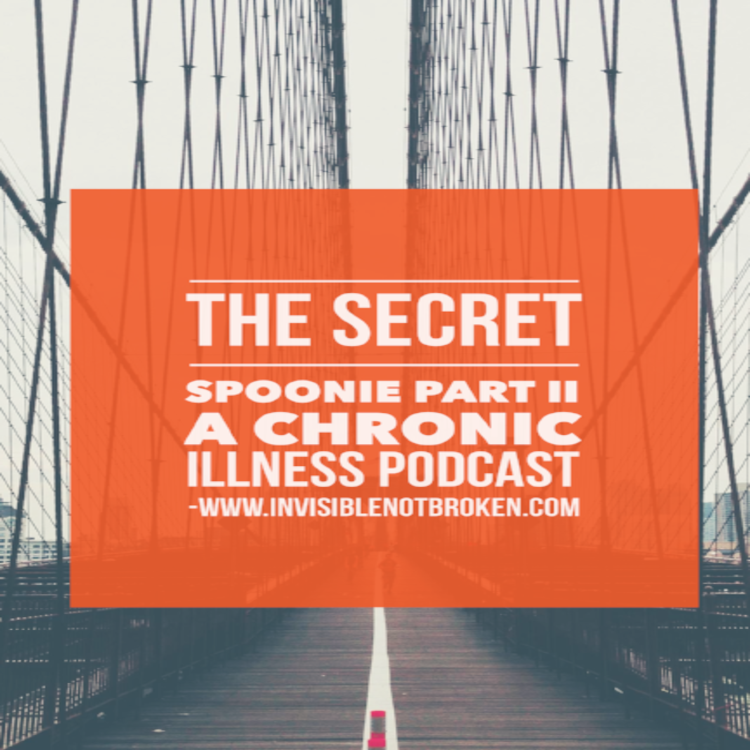
Invisible Not Broken - Chronic Illness Podcast Network
Secret Spoonie II A Chronic Illness Podcast
Sign up with your email address to receive news and updates.
First Name Last Name Email Address Sign UpWe respect your privacy.
Thank you! Hidden in Plain SightThe Life of a Secret Spoonie: Part Two: Origins
Hello everyone and welcome back to Hidden in Plain Sight. For those of you just joining me, my intent is for this to be a monthly column about the trials and tribulations of living life with invisible illnesses that (most) people don’t know about. To recap: Over the last twenty-eight years, I have had numerous major surgeries, and a handful of minor ones, in addition to dozens of other (often invasive) medical procedures. I’ve had organs removed and a metal plate and cage implanted in my neck. I have been formally diagnosed with Spinal Stenosis, Fibromyalgia, Ankylosing Spondylitis, Peripheral Neuropathy, Raynaud’s Syndrome, and Stage Four Endometriosis. I am not entirely closeted, as some people do know about my medical conditions, but for the most part I live my life in a state of semi-secret. I hope that what I write here will resonate with some of you who might be in a similar position, and let you know that you are not alone.
By now some of you may be wondering why I choose to live like this. The question I get most from people, when they hear about my medical situation, is “Why don’t you talk about that?” Often, this sounds less like a question and more like an accusation: as in: “Why didn’t I know about that?” And herein lies one of the many dilemmas of being a closeted chronically ill person; if the idea is that I choose, willingly, willfully, not to openly disclose my situation to everyone I meet, then why is the response often indignant surprise with a veneer of anger when I do? While those who are also chronically ill usually seem concerned, I get the distinct impression that people who are not chronically ill themselves feel almost entitled to know everything about what’s going on with my medical life. I don’t know why this is the case, but I have some theories.
I believe that today, in the twenty-first century, the age of social media everywhere and all that it offers, many people have come to expect unfettered access to a stunning amount of readily available information. Sometimes this information is of a very personal nature. Anyone can follow a celebrity on Instagram and immediately know what she ate for breakfast that morning. In today’s media saturated world, we have access to almost unlimited data; much of it what would probably be considered private in nature. With the click of a key, or the swipe of a finger, we can peer into the most intimate details of people’s lives; sometimes figuratively, sometimes literally. We now live in an era where privacy is no longer the expectation. In fact, some seem to see it as a sort of privilege. This, however, was not always the case.
I realize that many people with chronic pain often long for a diagnosis, sometimes for (what must be brutal) decades at a time. It was the exact opposite for me. I was diagnosed at a relatively young age, in my early twenties, at a time when most young people (myself included) long to be seen as “normal” while simultaneously trying to forge a sense of self-identity from the bittersweet ravages of post-puberty. It was this internal struggle that ultimately led to my decision to hide my invisible illness from the world at large. Of course, those in my innermost circle had to know, because how else could I describe my reasons for staying home to rest rather than going out with my friends on a Saturday night? More often than not, as soon as I heard the car pull away, I was on the couch with a heating pad. I think that, more than anything else, it was my desire not to be seen as “sick” that made me do it. As a newly minted young adult, I didn’t want to be thought of as not fun, the one left behind, or even worse, not invited in the first place. It was also the early nineteen eighties, long before social media was a glint in someone’s eye. There were no understanding online communities, safely anonymous support groups, no way to quickly search for what each new symptom meant. My biggest fear was always that I would be ostracized from my own social community; one based largely on having fun and sharing experiences together.
Turns out that my fears were not completely unwarranted; I have lost some friends along the way. With each additional diagnosis, or another surgery, certain people in my life have faded into the background. Some slipped slowly from the friend slot into the acquaintance one. Others disappeared entirely. In some cases, it felt like a natural progression, while in others it was a devastating loss. I guess you learn who your real friends are when the chips are down. Maybe the best thing about being a secret spoonie is also the worst thing about it: If I’m able to effectively hide my invisible illness from people, I don’t get their condescending pity, but I also don’t get the sweet understanding. As many of you already know, being chronically ill is a challenge in many respects, both physical and mental, and sometimes we need a little help from our friends, even when (maybe especially when) we don’t want to ask for it. Having an invisible illness makes things both easier and harder; we can hide in plain sight, but we also risk not being seen when we want to be…when we need to be. Living in secret has served me well in some respects; in others, not so much. My choice to live like this has been both a liability and a form of protective armor: the paradox of being closeted and chronically ill.
Thanks for reading. Until next time,
Secret Spoonie
If you have any comments or questions, or something you would like to see covered in a future column, please feel free to contact me at: secretspoonie@gmail.com
SubscribeSign up with your email address to receive news and updates.
Email Address Sign UpWe respect your privacy.
Thank you!More episodes
View all episodes
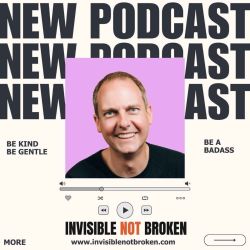
Vulnerability, Resiliency, and Advocacy with Tim Reitsma
47:06Monica Michelle is joined by consultant and podcast host Tim Reitma.Tim lives with Crohn's Disease.In this episode, Monica and Tim discuss: Tim’s resiliency through managing his Crohn’sThe importance of self-advocacy, especially in the workplace Tim’s podcast why he shares stories of those with invisible illness TIMESTAMPS00:47 - Tim's diagnosis 06:31 - How and why Tim applies self advocacy15:41 - Why Tim started his podcast22:42 - Invisible condition etiquette31:00 - What HR can do better for employees with invisible illness39:31 - Tools Tim uses to care for his Crohn’s outside the homeThe full transcript and all links mentioned can be found on the episode page on invisiblenotbroken.com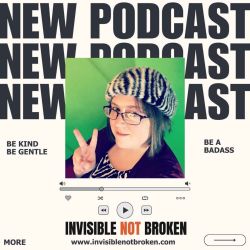
Tech and Disability: What VR Offers the Disabled Community with Sunny Ammerman
01:10:27Monica Michelle is joined by artist and disability advocate Sunny AmmermanSunny lives with Septo-optic dysplasia, panhypopituitarism, Optic Nerve Hypoplasia, and is missing a membrane in the brain called the "septum pellucidum".In this episode, Monica and Sunny discuss: Sunny’s complex disorders and how she copes with themEverything VR provides from accessible gaming, social platforms and the potential for better online education.Various VR/AR games and their gameplay Sunny’s VR support groupTIMESTAMPS00:45 - What VR/AR offers for chronically ill and disabled folks11:57 - Sunny’s conditions and how she copes with them17:55 - Features that make VR games accessible or inaccessible as well as different games and their play experiences37:13 - The social aspects of virtual gaming51:32 - What opportunities VR has for the future1:04:49 - Sunny’s VR support group The full transcript and all links mentioned can be found on the episode page on invisiblenotbroken.com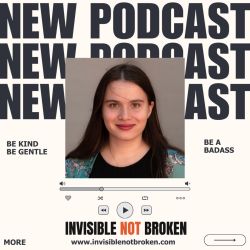
Reporting on Chronic Illness and Disability with Journalist Julia Metraux
39:16Monica Michelle is joined by Journalist Julia Metraux.Julia lives with vasculitis, mild to moderate hearing loss, and has experienced long COVID.In this episode, Monica and Julia discuss: Julia's diagnosis with vasculitis and how it influences her journalistic lensHow community impacts the mental health of those with chronic illnessHow Julia and Monica find positives and negatives in the internet spaces for chronically ill and disabled folksThe politics of how government, businesses, and celebrities influence the chronic illness community TIMESTAMPS00:32 - Julia's diagnostic journey07:02 - Julia’s work reporting on the online community of chronic illness 16:32 - The effect of Internet communities on chronically ill and disabled folks26:46 - How Julia’s illness impacts her work, both in what she writes about and how she manages her lifestyleThe full transcript and all links mentioned can be found on the episode page on invisiblenotbroken.com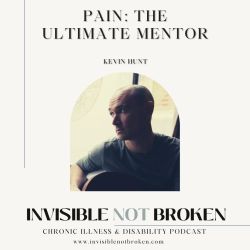
Author of “Pain: The Ultimate Mentor,” Physiotherapist Kevin Hunt
31:29Monica Michelle is joined by author & physiotherapist Kevin Hunt.Kevin lives with chronic pain.In this episode, Monica and Kevin discuss: Kevin’s philosophy of pain management as a physiotherapist who experiences chronic pain. The Hexagon Model, a life-management tool for focusing on what’s important to you.Kevin’s idea behind his new book.Using pain as a guide.TIMESTAMPS00:34 - Kevin’s work as a physiotherapist specializing in the experience of pain 06:44 - The Hexagon Model for managing your life’s needs14:00 - Putting aside the idea of a “quick fix”19:45 - Kevin’s personal experience with pain and how he uses it with patients28:44 - Kevin’s book, “Pain: The Ultimate Mentor”The full transcript and all links mentioned can be found on the episode page on invisiblenotbroken.com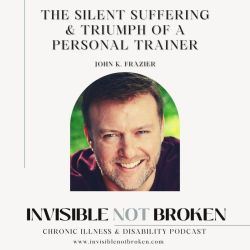
Author of “Through the Pain: The Silent Suffering & Triumph of a Personal Trainer”: John K. Frazier
28:35Monica Michelle is joined by author & personal trainer John K. Frazier.John lives with ankylosing spondylitis.In this episode, Monica and John discuss: John’s work as a physical trainer and authorChronic pain comparisonsPersonal triumphTIMESTAMPS00:50 - John’s business & diagnosis07:19 - Chronic pain olympics09:31 - Talking about & hiding a diagnosis15:09 - Personal triumph18:24 - Staying in the present23:29 - The superman complexThe full transcript and all links mentioned can be found on the episode page on invisiblenotbroken.com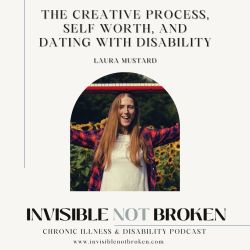
The Creative Process, Self Worth, and Dating with Disability: Laura Mustard
31:08Monica Michelle is joined by musician Laura Mustard.Laura lives with VATER syndrome.In this episode, Monica and Laura discuss: Laura’s inspiration for her upcoming musical EP.How Laura’s illness impacted her recent relationship & self-image.Laura’s creative process, new music, and social media pressure.TIMESTAMPS00:30 - Laura’s new EP / Monica’s recent COVID experience05:32 - Relationships with chronic illness11:20 - Image and self acceptance with disability15:32 - Laura’s creative process and current projects20:05 - Pursuing creativity despite social media attentionThe full transcript and all links mentioned can be found on the episode page on invisiblenotbroken.com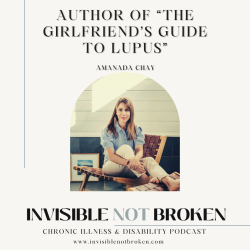
Author of “The Girlfriend’s Guide to Lupus”: Amanda Chay
30:43Monica Michelle is joined by author Amanda Chay.Amanda lives with Sjögren’s and Lupus.In this episode, Monica and Amanda discuss: Amanda’s book & diagnosisOutlooking on work & writingNavigating chronic illness with kids & familyTIMESTAMPS00:26 - Intro + The Girlfriend’s Guide to Lupus02:17 - Amanda’s diagnosis10:09 - Amanda’s outlook on writing17:11 - Navigating chronic illness with kids & family23:29 - Labels and roles26:24 - Flare reads & closing remarksThe full transcript and all links mentioned can be found on the episode page on invisiblenotbroken.com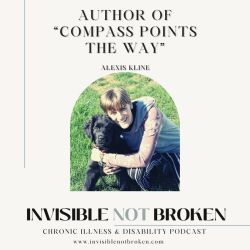
Author of “Compass Points the Way”: Alexis Kline
23:14Monica Michelle is joined by author Alexis Kline.Alexis lives with Dysautonomia.In this episode, Monica and Alexis discuss: Being a sick teenagerHaving an isolated diagnosisProductivity workflowsTIMESTAMPS00:28 - Alexis’s diagnosis & dog07:18 - Sick teenager road map10:00 - Alexis’s book & workflow16:25 - Having an isolated diagnosis20:50 - Wildlife photography, purchases The full transcript and all links mentioned can be found on the episode page on invisiblenotbroken.com
Author of “From the Sidelines to the Finish Line”: Emily Falcon
36:47Monica Michelle is joined by author Emily Falcon.Emily lives with ALCAPA.In this episode, Monica and Emily discuss: Growing up sickPost-surgery supportHaving a public bodySelf-motivation and adventuringTIMESTAMPS00:28 - Being a sick kid & Emily’s book title07:28 - Mortality10:16 - Portrayal of disability in media12:21 - Post-surgery support19:23 - Having a public body23:43 - Self-motivation29:46 - Emily’s tips for adventuresThe full transcript and all links mentioned can be found on the episode page on invisiblenotbroken.com